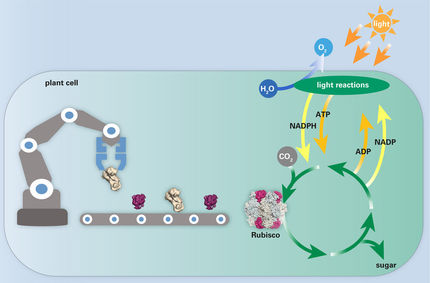Large conformational changes without ATP consummation
Energy saving chaperone Hsp90
A special group of proteins, the so-called chaperones, helps other proteins to obtain their correct conformation. Until now scientists supposed that hydrolyzing ATP provides the energy for the large conformational changes of chaperone Hsp90. Now a research team from the Nanosystems Initiative Munich (NIM) could prove that Hsp90 utilizes thermal fluctuations as the driving force for its conformational changes. PNAS reports on their findings.
ATP is the major energy source for most organisms and ATPases are the machines, which utilize this fuel, for example to move muscles or cargo in our body. The very abundant chaperone protein Hsp90 has such an ATPase in each of its two monomers. During the last years experiments had suggested that the movement and conformational changes of ATPase proteins are in general strictly linked to ATP binding and hydrolysis (i.e. fuel consumption).
To probe this theory Thorsten Hugel, Professor at the Technische Universitaet Muenchen (TUM) and member of the Nanosystems Initiative Munich (NIM), and his team designed a special three color single-molecule FRET (Förster resonance energy transfer) assay with alternating laser excitation (ALEX) for simultaneous observation of ATP binding and conformational changes. Unexpectedly the experiments revealed that binding and hydrolysis of ATP is not correlated with the large conformational changes of Hsp90. Hsp90 is instead a highly flexible machinery driven by thermal fluctuations.
"Thermal fluctuations are random changes in the structure of the protein – they can be thought of as collisions with water molecules in the environment, which move rather violently at the temperatures in a living organism," says Thorsten Hugel. "Using these clashes to switch back and forth between different conformations, saves Hsp90 valuable ATP." But then what is the task of ATPase in the Hsp90 chaperone? The scientists suspect that cochaperones and substrate proteins alter the system so that ATP binding or hydrolysis can take a crucial task.
With the newly developed experimental setup, it is now possible to investigate the very complex system in greater detail to resolve this important question. The Munich biophysicists therewith offer a new perspective on the energy conversion in molecular machines.
Original publication
Other news from the department science

Get the life science industry in your inbox
By submitting this form you agree that LUMITOS AG will send you the newsletter(s) selected above by email. Your data will not be passed on to third parties. Your data will be stored and processed in accordance with our data protection regulations. LUMITOS may contact you by email for the purpose of advertising or market and opinion surveys. You can revoke your consent at any time without giving reasons to LUMITOS AG, Ernst-Augustin-Str. 2, 12489 Berlin, Germany or by e-mail at revoke@lumitos.com with effect for the future. In addition, each email contains a link to unsubscribe from the corresponding newsletter.


















































